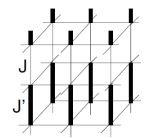EPJ B Highlight - Numerical validation of quantum magnetic ordering
- Details
- Published on 16 October 2013

Numerical simulations designed to confirm the magnetic characteristics of 3D quantum materials largely match the theoretical predictions
A new study set out to use numerical simulations to validate previous theoretical predictions describing materials exhibiting so-called antiferromagneting characteristics. A recently discovered theory shows that the ordering temperature depends on two factors—namely the spin-wave velocity and the staggered magnetisation. The results, largely consistent with these theoretical predictions, have now been published in a paper in EPJ B by Ming-Tso Kao and Fu-Jiun Jiang from the National Taiwan Normal University, in Taipei.
In antiferromagnetic materials, the spins of electrons align in a regular pattern pointing in opposite directions to their neighbours. The materials’ magnetic ordering conditions the temperature, referred to as the Néel temperature, above which the macroscopic magnetic ordering is no longer present.
The authors attempted to confirm a new universal law established between the thermal and quantum properties of these three-dimensional quantum antiferromagnets. Specifically, the law suggests that the Néel temperature can be related to the staggered magnetisation density near a quantum critical point (QCP). At that point, there is a special class of continuous magnetic phase transition taking place at the absolute zero of temperature, driven by quantum-level fluctuations.
In order to produce quantitative predictions, they simulated a specific three-dimensional relevant model using the first principles of approximation-free Monte Carlo calculations. The authors thus extracted the Néel temperature, the zero-temperature staggered magnetisation in the system and the spinwave velocity.
They found that the universal relation is valid to a great extent, while there is a discrepancy between the theoretical predictions and the simulation results. Further investigation, they believe, is required in order to better understand the discrepancy. For example, this could mean investigating whether the predicted universal relation is valid qualitatively or quantitatively for the same type and different type of quantum phase transitions occurring in other models than that considered here.
M.-T. Kao and F.-J. Jiang (2013), Investigation of a universal behavior between Néel temperature and staggered magnetization density for a three-dimensional quantum antiferromagnet, European Physical Journal B, DOI 10.1140/epjb/e2013-40726-6




